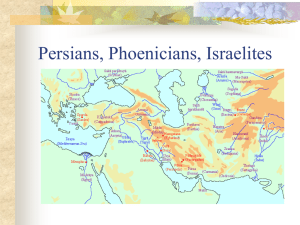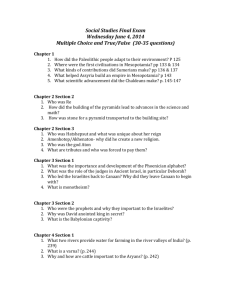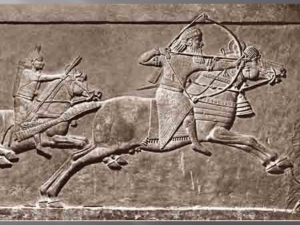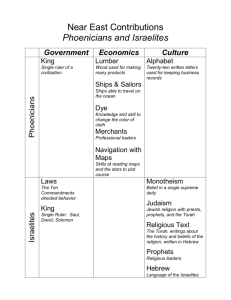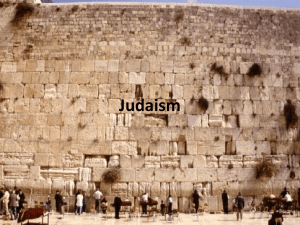World History Chapter 3
advertisement
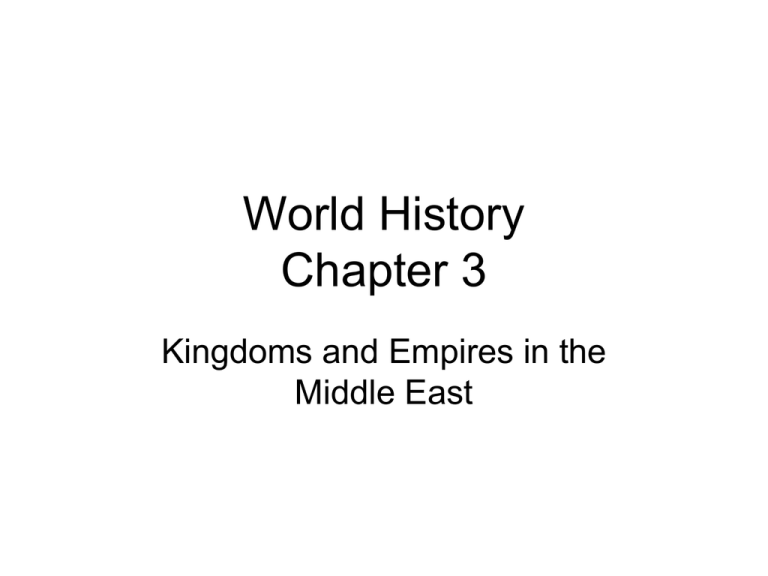
World History Chapter 3 Kingdoms and Empires in the Middle East Chapter 3, Section 1 Civilizations in Mesopotamia and Egypt trade and spread cultural influences throughout the region Setting the Scene • Terms to Define: confederation, alphabet, colony, barter • People to Meet: the Aramaeans, the Phoenicians, the Lydians, • Places to Locate: Syria, Damascus, Tyre The Aramaeans • • • • Highly active in Middle East trade Settled in Central Syria, 1200 B.C. Capital at Damascus Controlled trade route, Mesopotamia to Egypt • People in region spoke Aramaic, language of Aramaeans The Aramaeans • Until A.D. 800s, most people in Fertile Crescent spoke Aramaic • Parts of Bible written in Aramaic The Phoenicians • • • • Originally from Arabian Peninsula Settled in north Canaan Neighbors were Philistines Canaan was later called Palestine by the Greeks • They sailed the seas for a living The Phoenicians • Harvested timber from nearby forests to build strong ships • Built a string of towns and cities along the coast – Many grew to city-states—most significant was Tyre – Loose union of city-states forming a confederation. The Phoenicians • Sailed from their coast city-states throughout the Mediterranean • Expert navigators using stars and sun • Reached southern coast of Spain and possibly England • Took charge of Mediterranean shipping and trade The Phoenicians • Had advantage over business competitors because they had improved t alphabet • Phoenician system became foundation of several alphabets including Greek • Set up temporary colonies along the Mediterranean coasts • The colony of Carthage became the most powerful in the Mediterranean The Lydians • Lydians lived in Asia Minor • Developed wealthy kingdom • Neighboring cultures relied on system of trade called barter—exchanging their wares for other goods • Lydians established money system, using coins as a medium of exchange • The concept of money soon spread The Israelites were an exception among the polytheistic cultures of the ancient world. They were monotheistic, or believed in one all-powerful God. They called him Yahweh. The teachings of the Israelites influenced Christianity and Islam EARLY ISRAELITES CHAPTER 3, SECTION 2 The Land of Canaan • The Bible traces the origins of the Israelites to Abraham – Herder and trader – Lived in Ur in Mesopotamia – Believed God made covenant with Abraham – Would build a great nation around him if he remained faithful to God The Land of Canaan • Descendents of Abraham shared land with Phoenicians and Philistines • Rocky hills and deserts • Fertile plains and grassy slopes • Many lived as nomad herding sheep and goats The Exodus From Egypt • Abraham’s grandson, Jacob, raised 12 sons and each son led a separate family group – The 12 tribes of Israel – Severe drought forced migration to Egypt – They lived peacefully for several generations until the Egyptians decided to enslave them The Exodus From Egypt • In 1200s B.C., Moses led people from Egypt – Exodus into Sinai Desert – During Passover, Exodus story is retold • God renewed the covenant with Moses – Israelites ledged to reject all gods – Received Ten Commandments • God promised them safe return to Canaan Settling the Land • Moses died before reaching Canaan • Joshua led Israelites into Canaan • For 200 years, the Israelites fought the Philistines and Canaanites who now occupied the land The Davidic Monarchy • Israelites united under one king—Saul • Unable to defeat the Philistines, David became king • David had once defeated Goliath • David ruled for next 40 years • King David set up capital in Jerusalem • Israelites enjoyed prosperity under David The Davidic Monarchy • David’s son Solomon succeeded his father – Founded new cities and constructed magnificent temple in Jerusalem – Israelites resented Solomon’s high taxes – Ten tribes broke away from the other two • Two in the north broke away from southern tribes • Ten in the south kept the name of Judah as a kingdom and kept Jerusalem as the capital • “Jew” comes from the term Judah Exile and Return • Politically split, tribes kept same religion • Too weak to resist invasions • In 722 B.C., the Assyrians of Mesopotamia conquered the 10 tribes • IN 586 B.C., the Chaldeans of Mesopotamia gained control of Judah and destroyed the temple Exile in Babylon • During the difficult period, prophets arose from the Israelites • Some like Jeremiah blamed the Jews for leaving God • Without a temple, Jews met in small groups—the rise of synagogues came from these gatherings Rebuilding Jerusalem • In 539 B.C., the Persian conquered the Chaldeans – Persian king Cyrus II allowed the Jews to return to Judah and rebuild the temple – First five books of Bible were placed in Torah • Some Jews remained in Babylon and and other went to other regions—the Diaspora—Greek word for scattered Lasting Legacy • Jews saw God-directed purpose and continued to record their history • Torah recorded concept that humans were made in the image of God • People were accountable for what happens in the world Warlike neighbors came to rule the Fertile Crescent EMPIRE BUILDERS CHAPTER 3, SECTION 3 Setting the Scene • Terms to Define: satrap • People to Meet: the Hittites, the Assyrians, the Chaldeans, Nebuchadnezzar, the Persians, Cyrus II, Darius I, Zoroaster • Places to Locate: anatolia, Babylon, Nineveh, Persepolis The Hittites • Presumably from areas beyond the Black Sea, conquered Asia Minor 2000 B.C. • Established city-states in central plain called Anatolia • Custom of wearing hair in long, black pigtail • First to Wield iron weapons The Hittites • Two soldiers on a chariot—fast, light, mobile, strong • Conquered Babylon about 1595 B.C. • Established less harsh legal system than Hammurabi The Assyrians • Subject of constant attacks to their home in north Mesopotamia • Built strong force and starting attacking others – Most lethal fighting force in Middle East – Chariots, cavalry, foot soldiers – Used iron weapons and battering rams to knock down wall of foes The Assyrians • Treated conquered people cruelly – Burned cities – Tortured and killed thousands – Deported people to other parts of their kingdom – Resettled other people into conquered territories The Assyrians • By 650, Assyrians governed empire from Persian Gulf to Asia minor • Established capital in Nineveh, along Tigris River • Alliance between Chaldeans and Medes brought down the Assyrian empire The Chaldeans • Descended from Hammurabi’s Babylonian empire • Height of empire was during reign of King Nebuchadnezzar • Conquered Canaan and Syria • Built Babylon into beautiful city The Chaldeans • Among seven wonders of the world, Hanging Gardens of Babylon – Made for the king’s wife – Walls 50 feet high around the city • Study of stars laid foundations of study in Astronomy • Persians under Cyrus II conquered them The Persians • From central Asia, leaving about 2000 B.C • Settle between Persian Gulf and Caspian Sea • Between Cyrus and his son, Cambyses, they brought all of the Middle East under Persian control The Persians • Darius I was best organizer – Reigned 522 B.C. to 486 B.C. – Divided the realm into provinces—satraps— provincial governors – Military officials and tax collector chosen from the conquered people – Inspectors made tours—”eyes of the king” – Believed in loyalty over fear The Persians • Persian did not participate in trade—their conquered people could • Expanded network of roads for trade – Royal road stretched more than 1500 miles across Persian Empire – Stations every 14 miles The Persians • Darius waged war against the Greeks • After Darius death, his son Xerxes led disastrous campaign against Greeks in Greece in 480 B.C., crippling the Persian empire (partly against the “300”) The Persians • Followed strict code of bravery and honesty – Taught riding, use of the bow and speaking the truth • Worshiped many deities • Prophet, Zoroaster, began speaking of a world divided into good and evil The Persians • Zoroaster – Humans caught up in the struggle – Humans must choose – Eternal life was the reward – Written in book called Avesta • Persian kings led by good god, Ahura Mazda The Persians • Zoroaster’s teachings linked to glorification of Persian monarchy • Zoroaster’s teachings on paradise, hell, and Last Judgment may have influenced other religions • Persians mixed with Greek culture when Alexander the Great absorbed them
